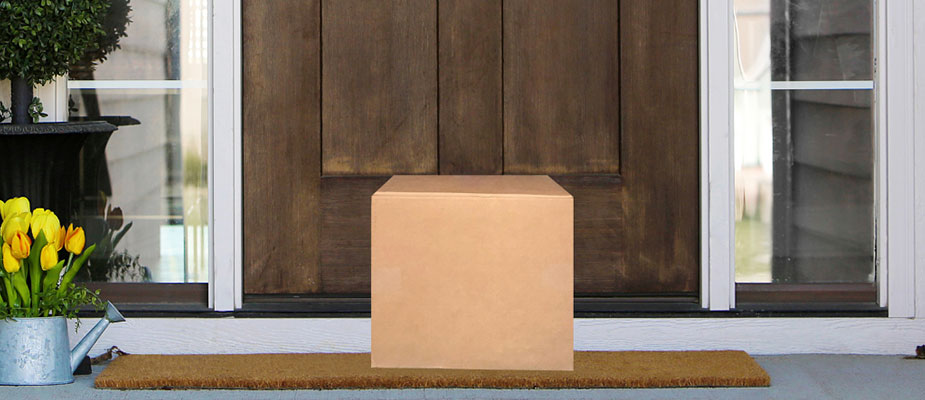Four words your customer never wants to read: Your package is delayed.
Unfortunately, these words pop up on our screens now more than ever.
Why? Another word: Capacity.
2021 has been a year plagued by capacity issues. From lack of shipping containers to shortages in parcel carriers, what many call the parcel problem has managed to work through the entire supply chain, now affecting last mile delivery solutions in lost-revenue, disappointed-customer kind of ways. The need for alternative delivery methods has never been greater.
Current Parcel Capacity Status: Unknown
Parcel carrier capacity has become a big-time concern for many retailers.
Parcel companies are trying to keep up, but the lack of workforce, paired with heightened E-Commerce demand, have created major constraints.
The inability to fulfill orders has left parcel companies with no choice but to cut or cap capacity — capacity previously committed to retailers. In addition, parcel companies are also charging retailers surcharges on package volumes that exceed contractual commitments, as well as set weight or dimension.
Yep, you heard that right. Surcharges. More on them in a bit.
Retailers are always worried this time of year, heading into the holiday rush. But now, in this new world, to say retailers are worried would be a gross understatement. It’s more like they’re worried to the nth degree.
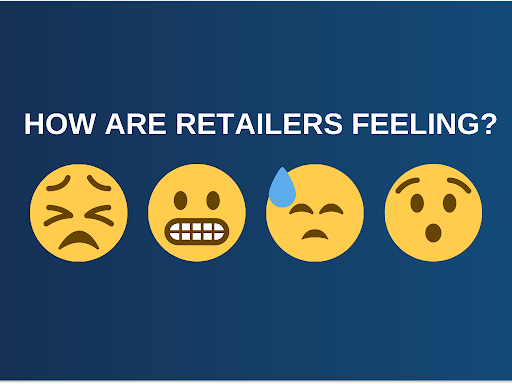
While experts believe the 2021 holiday season is not expected to surpass 2020’s numbers, demand placed on the nation’s delivery network is predicted to exceed capacity by about 4.7 million parcels a day.
With expectations surrounding high E-Commerce demand and growing customer expectations for fast, same-day delivery, shippers are scrambling to find retail logistics solutions that can keep up with peak shipping season. Here are some strategies worth exploring:
Go Hybrid
Many retailers are finding ways to use their own employees alongside their internal fleet. This method has gained popularity for retailers who need assistance in matching the influx of demand.
Hiring more employees and drivers can be costly. Utilizing a third-party to rate shop for you and carry out deliveries when demand surpasses supply is the perfect solution.
Incentivize Customers
Expectations are high, yet customers are understanding. Fast and free shipping has become a challenging offering. So challenging, at times, that many retailers were forced to turn off on-demand shipping offers.
One way to limit the number of on-demand deliveries is to offer an incentive for those who are willing to wait longer for their delivery. Think about your own experience as a consumer: If you were offered a 15% off discount at checkout, or $10 off a subsequent purchase, that might entice you to hold off a bit longer for your items.
Communicate, Communicate, Communicate
Live delivery updates have become the expectation. Communication is crucial between retailers and their customers. A delay is bad, but a delay with silence is often lethal.
Providing delivery updates not only supplies the customer with visibility, but also adds a personal touch to their experience.
Better yet, provide them with the ability to change delivery outcomes.
Multi-Carrier Solutions
Utilizing multiple shipping carriers provides flexibility for retailers at a time when their preferred courier is unable to complete a delivery. However, partnering with multiple shipping carriers can be incredibly time-consuming.
Customer Satisfaction Is on the Line (Along with Your Bottom Line)
The need for efficient last mile delivery solutions are only increasing as retailers continue to balance bottom-line costs with customer satisfaction. As consumers continue to adapt to the new normal of on-demand delivery expectations, retailers need to ensure they have reliable delivery. We’ve come to see that using one courier just won’t cut it.
For years, retailers have relied heavily on a single courier service to carry out the bulk of their last mile deliveries. However, putting all their eggs in one basket is tricky because when capacity falls short, disruptions occur — delivery disruptions that could’ve been avoided with an alternative solution in place.
Expectations are rising and retailers need to ensure their delivery operations are buttoned up. One simple delay in the delivery process has the ability to completely tarnish a brand’s reputation. Is that a risk retailers are willing to take?
Sure, some delivery disruptions are inevitable, but retailers need to ensure the ones that do occur are unavoidable.
One trend we’re currently seeing is retailers taking 10 days or more to simply process the orders, let alone ship them. The reason? Worker shortages.
One customer shared that they placed an order with a leading apparel retailer on the 11th of this month, then received the following email notification on September 21:

Yikes! These are unprecedented times. Still, we see these types of delays as avoidable.
By implementing a multi-courier network, or at least sourcing a backup courier, retailers have the ability to ensure timely delivery and keep customer loyalty intact.
Fact is, 70% of customers say they would not make another purchase from a shipper after a negative delivery experience. And 84% of shoppers won’t return to a company that doesn’t deliver on time.
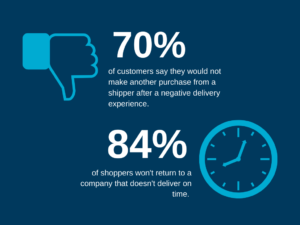
Shipping Surcharges: Brace Yourself
As if customer satisfaction wasn’t reason enough for retailers to seek alternative shipping solutions, surcharges are another sobering factor to consider. Over the last year, surcharges have become more than a reality; they’re now a given.
To offset rising delivery costs, leading carrier companies like the U.S Postal Service (USPS) plan to add surcharges on packages delivered during the holiday season. These surcharges won’t just affect big-box corporations — surcharges are going into effect for anyone looking to ship something, even Great-Grandma sending her world-famous fruitcake.
Surcharges implemented by USPS range from 25 cents to $5 and are in line with industry practices.
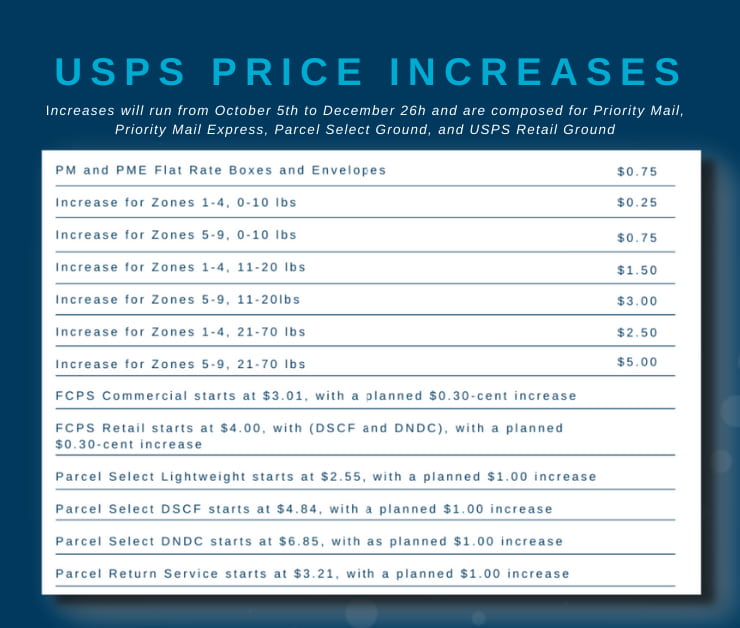
UPS and FedEx are also following industry practices by increasing base prices and additional surcharges.
Surcharges imposed by USPS are said to run from October 15, 2021, to January 15, 2022, and will primarily apply to large customers. The added fees are set to run as much as $6.15 extra per package — exceeding pre-pandemic shipping levels.
FedEx, on the other hand, announced a series of surcharges during peak shipping season.
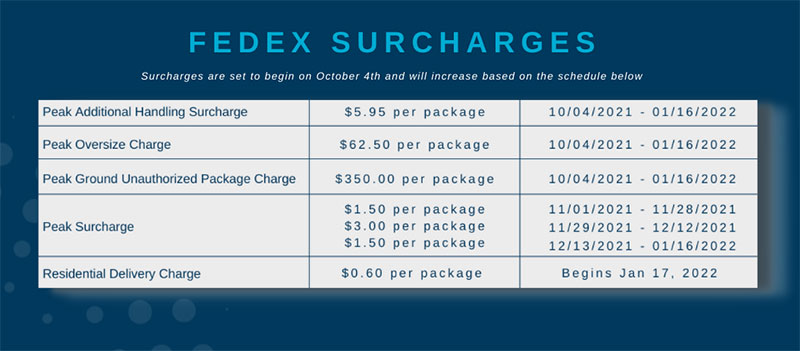
The first surcharge cycle is set to begin on October 4, and includes levies on shipments that typically require extraordinary handling — often these are shipments that move outside of FedEx’s main processing stream. These shipments now carry a $5.95 per-package surcharge.
A $1.50-per-piece levy will be imposed beginning November 1 (and ending on November 28). The following day, another round of surcharges will be enforced, doubling the prior fee at $3 per package. That surcharge schedule will run until November 12. On the 13th, the levy will go back to its original $1.50 fee.
Oversized items also pose an oversized problem when it comes to surcharges, so be prepared to pay bigger fees for bigger items.
FedEx will be enforcing a $62.50-per-piece charge on oversized items that do not fit the company’s conveyable process. In addition, FedEx will be enforcing an additional $350-per-package charge — yes, you read that right! — on unauthorized shipments that FedEx does not recommend because their large sizes and weights make them more appropriate for LTL shipping and handling rather than parcel.
If they’re not absorbing those costs themselves, how many retailers do you know who would be comfortable passing on a hefty $350 fee to their customers?
Parcel Alternatives: A Primer
As we’ve mentioned, today’s competitive marketplace makes it entirely plausible that even just one delivery delay can compromise a customer’s loyalty. As a result, retailers need to be ready with a backup plan this holiday season.
Source regional carriers
You can no longer put your faith in one major carrier. Surcharges are adding up, and capacity is uncertain. Adding regional carriers into the mix is one way to reinforce your last mile delivery plan when capacity falls short.
Sourcing regional carriers brings big benefits:
Cost Savings
In working with regional carriers you not only can benefit from lower freight rates but also fewer surcharges.
Regional carriers often transport their packages using truck hubs, rather than airfreight. This alone can save shippers 10-40% compared to national parcel carriers.
While surcharges may be added by some regional carriers, it is unlikely they will impose the same fees charged by national parcel carriers.
Most regional carriers do not charge for weekend deliveries, or rural areas commonly seen as added fees for national carriers.
Faster Delivery Times
Faster delivery is another common benefit when using regional carriers. Most regional carriers specialize in next-day and same-day delivery, as well as different freight shipping options. Not only does utilizing a regional carrier help offset the delivery congestion seen in peak shipping season, it has the ability to increase delivery times for customers while also cutting costs.
Using regional carriers is the perfect solution for shippers who have a high amount of customers in a dense population. Shippers can orchestrate their shipment to reach a regional carrier to carry out the last mile of the delivery.
Negotiating Power
In an effort to compete with national carriers, many regional carriers are flexible when determining their rates. To be able to offer your customers predictable pricing goes a long way in winning their business again and again.
Some regional carriers also offer additional value-added services in delivering heavy or fragile items without the additional rates added. If you can afford to offer these services at no additional cost, don’t keep it a secret — make it known to your customers throughout your communication channels.
While there are many upsides to using regional carriers, it’s important to note that building relationships can be time-consuming.
Let’s say you have 15 regions that need to be covered. If you choose to use regional carriers, you need to source 15 different regional carriers and build relationships with them. That’s a lot of back-and-forth conversations, no matter how you slice it — over email, over the phone, etc. The problem looms larger as the number of regions needing coverage grows.
Luckily, aggregated networks have been built to eliminate this time suck. OneRail’s connected courier network allows you to instantly access over 8.2 million delivery drivers with a single integration.
Instant Elastic Demand, a.k.a. Connected Capacity
Another solution, and probably the most feasible in overcoming the parcel problem, is sourcing a solution that provides instant capacity on demand. In our current state of unpredictable capacity, shippers need a solution that provides flexibility and optionality to leverage many networks and modes. At OneRail, we call this connected capacity — many networks, many modes.
Upon integration, a shipper has instant access to a wide range of courier drivers, parcel carriers and freight carriers at the best price. The OneRail Logistics Partner team builds and grows personal relationships with each partner in our network to negotiate the best rates for our shippers.
Upon API integration, our shippers’ delivery jobs are matched with the best delivery partner at the best price in milliseconds through our automated rate shopping shipping software.
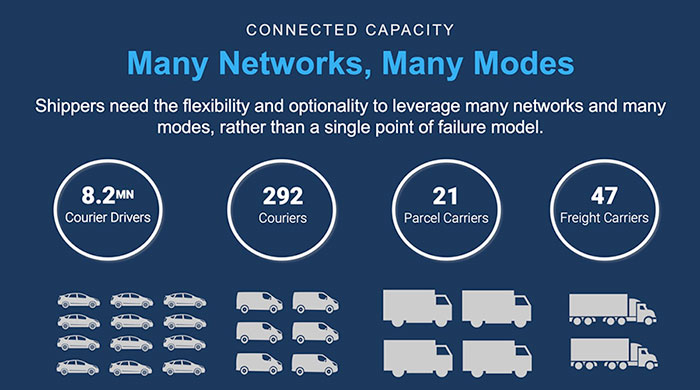
Leading parcel companies are desperately seeking new solutions as an attempt to manage demand. The USPS has reportedly invested in 138 package-sorting machines as well as leased an additional 45 package annexes, in preparation for the holiday shipping crunch. As part of their 10-year “Delivering for America” plan, the USPS intends to boost efficiency and profitability.
Exceptions Needn’t Rule Your Customer Experience
The implementation of package-sorting machines and additional annex facilities are the kind of solutions companies are banking on this season. Rather than delivering packages through parcel, couriers in the network can deliver Same-Day, Next-Day or Later Delivery. And using the OneRail Courier Network means the delivery status is always known, and can be rerouted, even when delivery exceptions occur.
The ability to change a delivery outcome from Delayed or Missed or Failed or Wrong Address to Successful Delivery is a game-changer among today’s last mile delivery solutions, especially since it’s so easy for details to fall through the cracks when deliveries are at an all-time high.
With OneRail’s Exceptions Assist™ team, customers get the delivery experience they deserve. Every delivery that enters the platform is closely monitored and managed to ensure that agreed-upon service levels are met.
Get All Your Parcel Questions Answered Oct. 12
It’s important to note that the current parcel problem we’re facing won’t be solved overnight. Retailers and supply chain experts are working hard to optimize efficiencies and ensure their customers are presented with the best possible delivery experience.
Interested in learning more about how industry experts are handling the parcel problem? Got questions you’re not equipped to answer? Join us Tuesday, October 12, for our one-hour webinar, The Parcel Pinch: Your Year-End Guide to Reducing Risk in Last Mile Delivery.
Registration is free and includes a live Q&A with supply chain influencers Neil Ackerman of Johnson & Johnson, Bill Hancock of US Foods, Chris Cashin of IndyShip and OneRail CEO Bill Catania. E-Commerce expert Nate Skiver will moderate the panel.
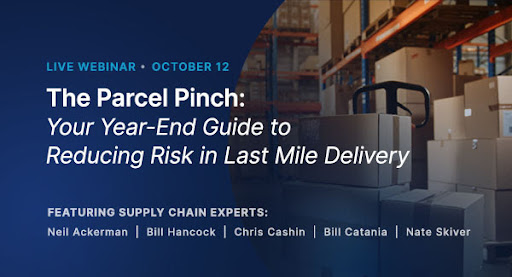
Links for Further Reading:
FreightWaves Talks Courier Capacity Issues

